![]()
Electrical Products & Services
Explore the top 6 off-grid battery systems of 2025, highlighting their unique features and benefits for reliable energy independence.
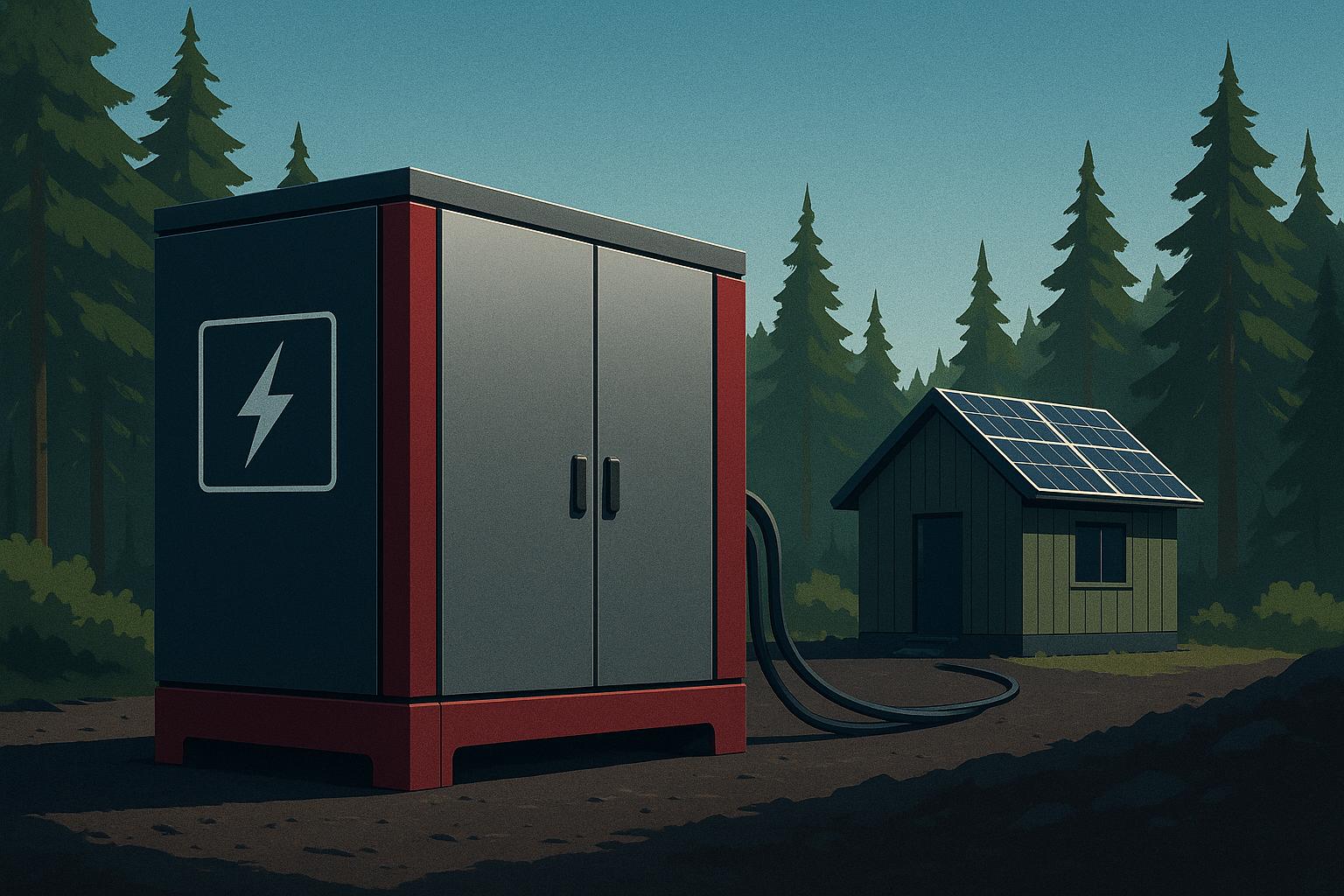
Looking for the best off-grid battery system in 2025? Here’s a quick guide to the top options, their features, and what makes them stand out. Whether you need reliable backup power or complete energy independence, these systems deliver durability, scalability, and smart features to meet your needs.
| Feature | Bluetti EP900 | Franklin aPower2 | OMO Lithium Batteries | Tesla Powerwall 3 | Sonnen Ecolinx |
|---|---|---|---|---|---|
| Usable Capacity (kWh) | 9–39.6 | 15–225 | 5.12–32 | 13.5–216 | 12–30 |
| Cycle Life | 3,500+ | 10,000+ | 6,000+ | Unlimited | 15,000 |
| Warranty | 10 years | 15 years | Varies by model | 10 years | 15 years |
| Smart Features | App monitoring | Advanced app | Real-time monitoring | Tesla app | AI energy control |
| Price | Starts at $10,298 | Varies | Starts at $2,676.30 | Varies | Varies |
These systems cater to different budgets and energy needs. Bluetti EP900 is ideal for scalability, while Franklin aPower2 offers unmatched durability. OMO Batteries shine in cold climates, and Tesla Powerwall 3 excels in efficiency. For smart home enthusiasts, Sonnen Ecolinx integrates seamlessly with automation systems. Choose based on your energy use, future growth, and budget.
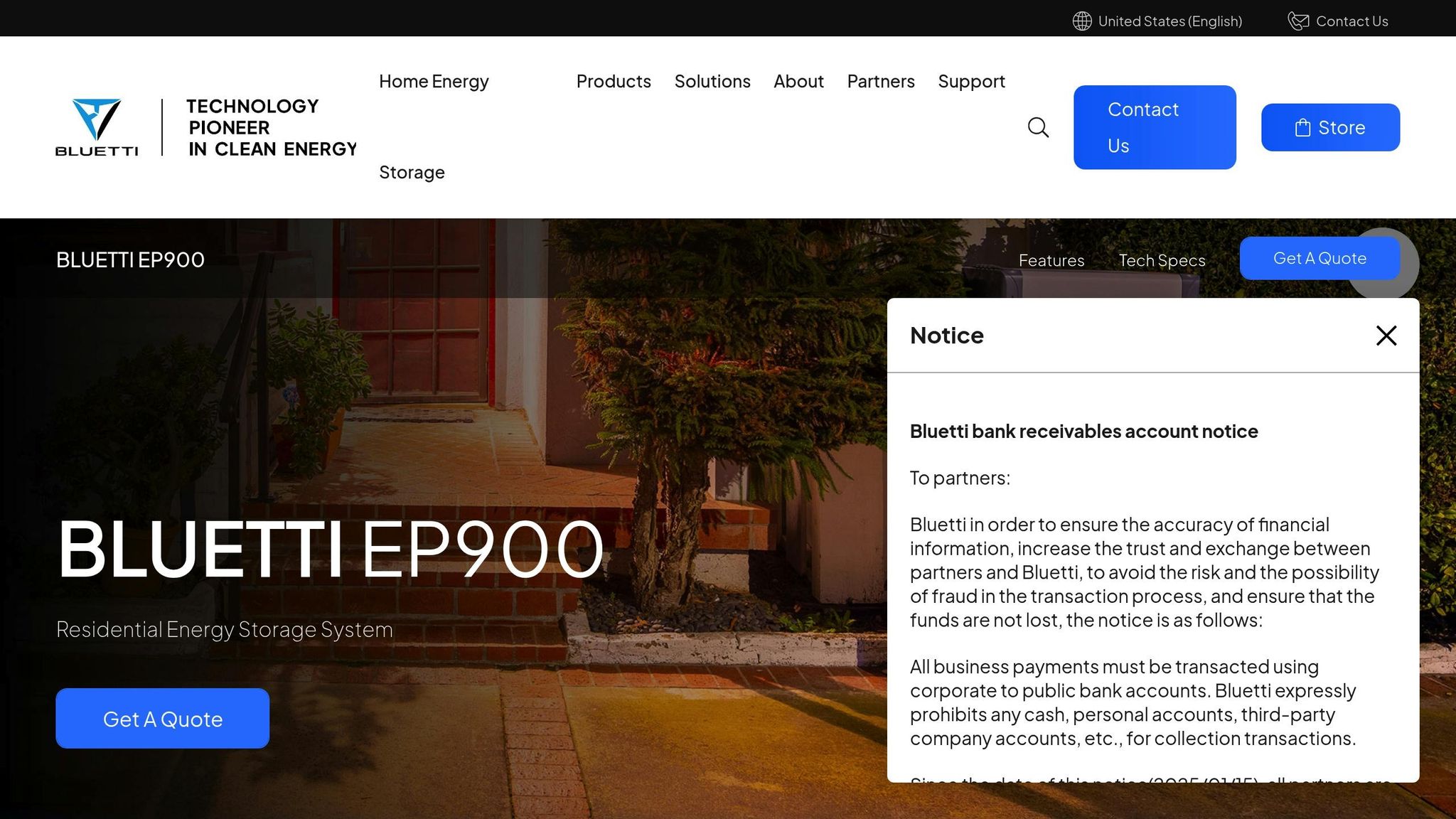
The Bluetti EP900 is a modular energy system designed to provide reliable off-grid power with customizable capacity and seamless solar integration. Built with LiFePO4 batteries, it offers exceptional safety and durability. Let’s take a closer look at its performance and features.
The EP900’s capacity is fully adjustable, depending on how many B500 battery packs you connect. Each B500 pack offers a total capacity of 4,960Wh, with an effective capacity of 4,464Wh due to its 90% depth of discharge. You can configure the system with 2 to 4 B500 packs to suit your energy needs.
This modular design allows you to start with a smaller setup and expand as your energy requirements grow.
The EP900’s LiFePO4 batteries are built for the long haul, offering over 3,500 cycles. Each B500 module is rated for an energy throughput of 15.48 MWh, and a setup with four packs can handle up to 61.92 MWh over its lifespan.
Bluetti guarantees that the battery system will maintain at least 80% of its original capacity by the end of the warranty period, ensuring consistent performance for years to come.
The EP900 is supported by a 10-year warranty, covering the entire system regardless of the configuration you choose. Whether you opt for 2, 3, or 4 B500 batteries, you’ll enjoy the same coverage and peace of mind, with the assurance of 80% capacity retention by the end of the warranty.
Managing the EP900 is simple with the Bluetti app, which connects via WiFi or Bluetooth. This app puts you in control, letting you:
You can also choose from four operating modes – Backup, Self-consumption, Time of Use, and Custom – to optimize energy usage for your needs. Plus, the app supports wireless updates, so your system can stay up-to-date with new features and improvements without needing a technician.
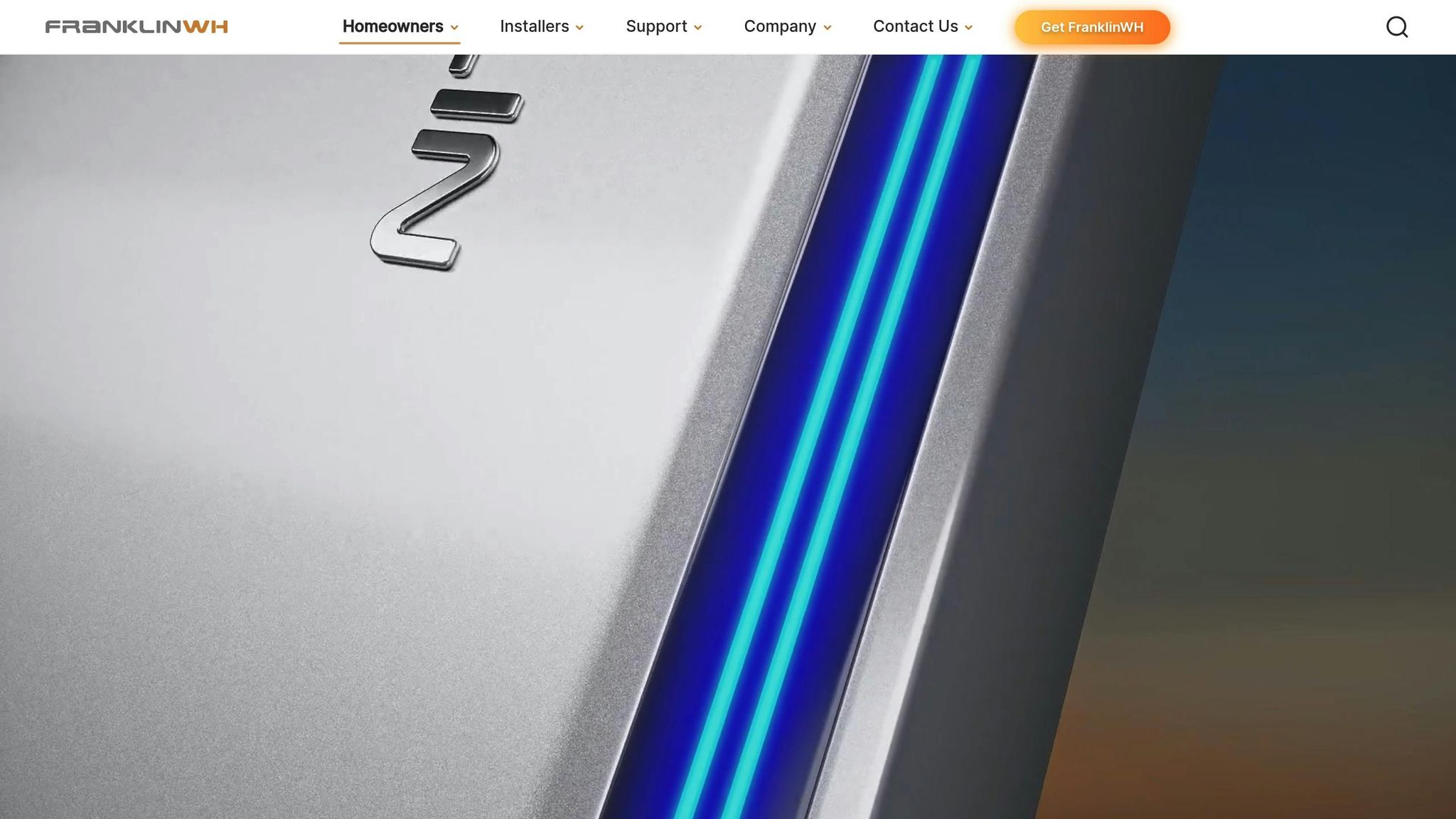
The Franklin aPower2 is a powerful, whole-home energy storage solution designed for off-grid living. Built with Lithium Iron Phosphate (LFP) technology, it offers safety, durability, and enough capacity to meet the energy needs of an entire household.
"The aPower 2 is the cutting-edge second-generation home energy battery within the FranklinWH energy ecosystem, storing energy from solar, grid, generator, and EV. A single aPower 2 can power your entire home day and night or during outages." – FranklinWH
Here’s a closer look at its key features and performance:
With 15 kWh of usable capacity in a single unit, the aPower2 can handle most household energy demands, including high-consumption appliances like air conditioners. For larger energy needs, you can connect up to 15 units to a single aGate controller, reaching a combined capacity of 225 kWh. The system delivers 10 kW of continuous power and can manage surge currents strong enough to start a 5-ton air conditioning unit alongside other essential appliances. This flexibility makes it suitable for a range of household sizes and energy requirements.
The aPower2 is built to last, offering over 10,000 cycles. Even with daily use, this translates to decades of reliability, supporting a total energy throughput of 60 MWh over its lifetime.
Franklin provides a 15-year warranty for the aPower2, covering over 10,000 cycles and guaranteeing 60 MWh of energy throughput. This long-term coverage reflects the system’s durability and ensures peace of mind for homeowners.
The aPower2 pairs with the FranklinWH App, giving you real-time control and insights into your energy usage. Through the app, you can monitor energy data, analyze consumption patterns, and manage power sources remotely. During outages, the system’s Smart Circuit feature automatically turns off high-energy appliances to conserve battery life. Users can manually control these circuits or set minimum battery charge thresholds for added flexibility.
Additional features include an LED light strip that visually displays the battery’s charge level and Bluetooth connectivity, allowing for system monitoring even without internet access. The aGate intelligent controller integrates seamlessly with multiple power sources, including solar panels, the grid, generators, and EV chargers, ensuring an optimized energy supply.
With an IP67 rating, the aPower2 is fully protected against dust and can withstand water immersion up to 3.3 feet for 30 minutes. This makes it reliable for outdoor installations, even in harsh weather conditions.
The Franklin aPower2 combines robust capacity, smart technology, and durability, making it a dependable choice for off-grid living.
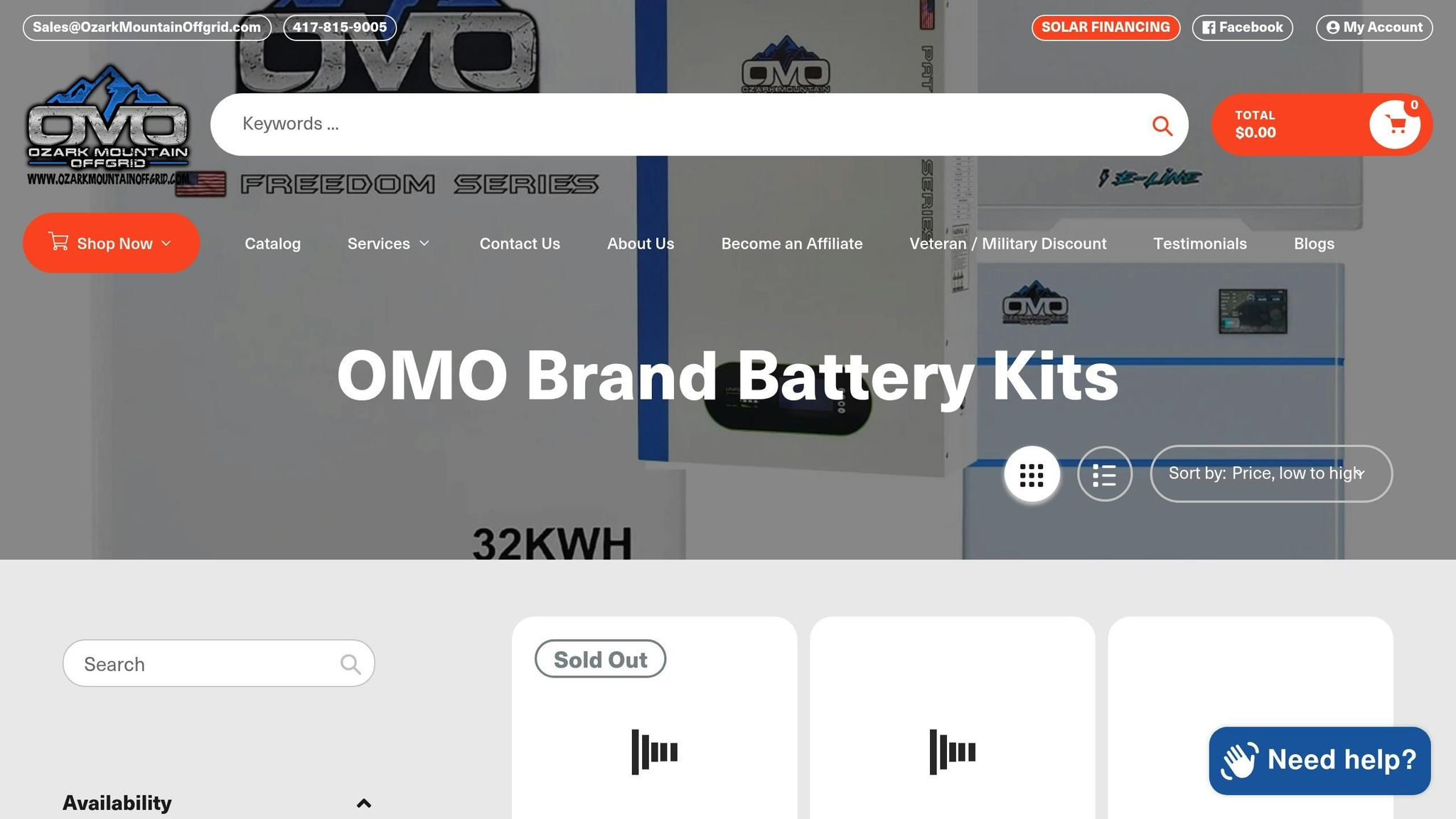
OMO Lithium Batteries stand out with their modular design and rigorous testing at the OMO Offgrid Farm. Built with LiFePO4 technology, these batteries prioritize safety and durability, making them a reliable option for various off-grid applications, from small homes to mid-sized businesses.
What sets OMO apart is its commitment to real-world testing and compatibility with inverters like the Sol-Ark 15K, ensuring smooth integration for complete off-grid systems. Below, you’ll find key details about their capacity options, lifespan, and monitoring features.
OMO offers a range of battery series tailored to different needs:
These batteries are equipped with heated technology, ensuring consistent performance even in cold climates where traditional batteries often struggle. This makes them particularly well-suited for off-grid setups in northern regions or high-altitude areas.
OMO Lithium Batteries deliver over 6,000 cycles – far exceeding the typical 3,000–5,000 cycles of standard batteries. This translates to a lifespan of 10 to 15 years with daily use, offering a dependable and cost-efficient solution for long-term off-grid power needs.
In off-grid scenarios, where batteries are frequently charged and discharged, this extended cycle life proves invaluable. OMO batteries can provide reliable power for over a decade, reducing replacement costs and ensuring uninterrupted energy supply throughout their lifespan.
OMO batteries come equipped with an advanced Battery Management System (BMS) that tracks critical metrics like current, voltage, temperature, and state of charge. Some models also include Bluetooth and WiFi connectivity for remote monitoring.
This intelligent system ensures optimal battery performance by sharing real-time data through wired or wireless connections, allowing seamless integration with other off-grid components. These monitoring capabilities not only enhance safety but also help maximize the battery’s lifespan, making them an excellent choice for demanding off-grid installations.
The Tesla Powerwall 3 offers advanced energy storage and management for homes, but it lacks support for external backup sources like generators. With its combination of high storage capacity and smart energy management, it’s an appealing option for homeowners looking for reliable backup power. However, its limitations make it less ideal for complete off-grid setups.
One of the standout features of the Powerwall 3 is Tesla’s energy management software. This system intelligently prioritizes power distribution during outages, ensuring that essential appliances and systems are powered first. That said, for users planning a fully off-grid setup, the inability to integrate external backup sources like generators could be a drawback. This makes the Powerwall 3 most effective as part of a hybrid energy solution rather than a standalone off-grid system.
The Powerwall 3 provides 13.5 kWh of usable capacity, with the option to expand by adding up to three additional 13.5 kWh packs. This setup can reach a total of 54 kWh per unit.
For larger energy needs, Tesla allows up to four Powerwall 3 units to be linked on a single-phase supply. This configuration delivers an impressive 216 kWh of storage, making it suitable for anything from small homes to properties with substantial energy demands.
It’s important to note that the Powerwall 3 is not compatible with earlier models like the Powerwall 2 or Powerwall Plus. This means existing Tesla battery owners cannot combine different generations within the same system.
Tesla offers a 10-year warranty for the Powerwall 3, guaranteeing that the battery will retain at least 70% of its capacity by the end of the warranty period. This warranty is based on 100% depth of discharge, meaning the battery can be fully discharged without causing damage or voiding the warranty.
"The Tesla Powerwall is backed by a 10-year warranty that guarantees that the battery will retain at least 70% of its capacity by the end of the warranty period." – SolarReviews
It’s worth noting that the unlimited cycle warranty applies when the system is used for solar self-consumption, time-based control, and backup reserve. Although Tesla hasn’t explicitly stated that off-grid use voids the warranty, the lack of external generator support could complicate things for true off-grid users.
The Tesla app is the central hub for managing and monitoring your Powerwall 3. Through the app, you can access real-time data on your home’s energy consumption, helping you optimize usage and pinpoint energy-intensive appliances.
With a 97% round-trip efficiency, the Powerwall 3 minimizes energy loss during charging and discharging. Tesla has also improved its time-based control feature, which charges the battery when electricity rates are low and discharges it when rates are high – a major benefit for grid-connected users.
Another standout feature is Storm Watch, which monitors local weather forecasts and ensures the battery is fully charged before severe weather events, maximizing your backup power.
However, some users have reported occasional glitches with the Tesla app, which could pose challenges for those relying on the system for critical off-grid operations. Despite these issues, the Powerwall 3 remains a strong contender among the top energy storage solutions for 2025.
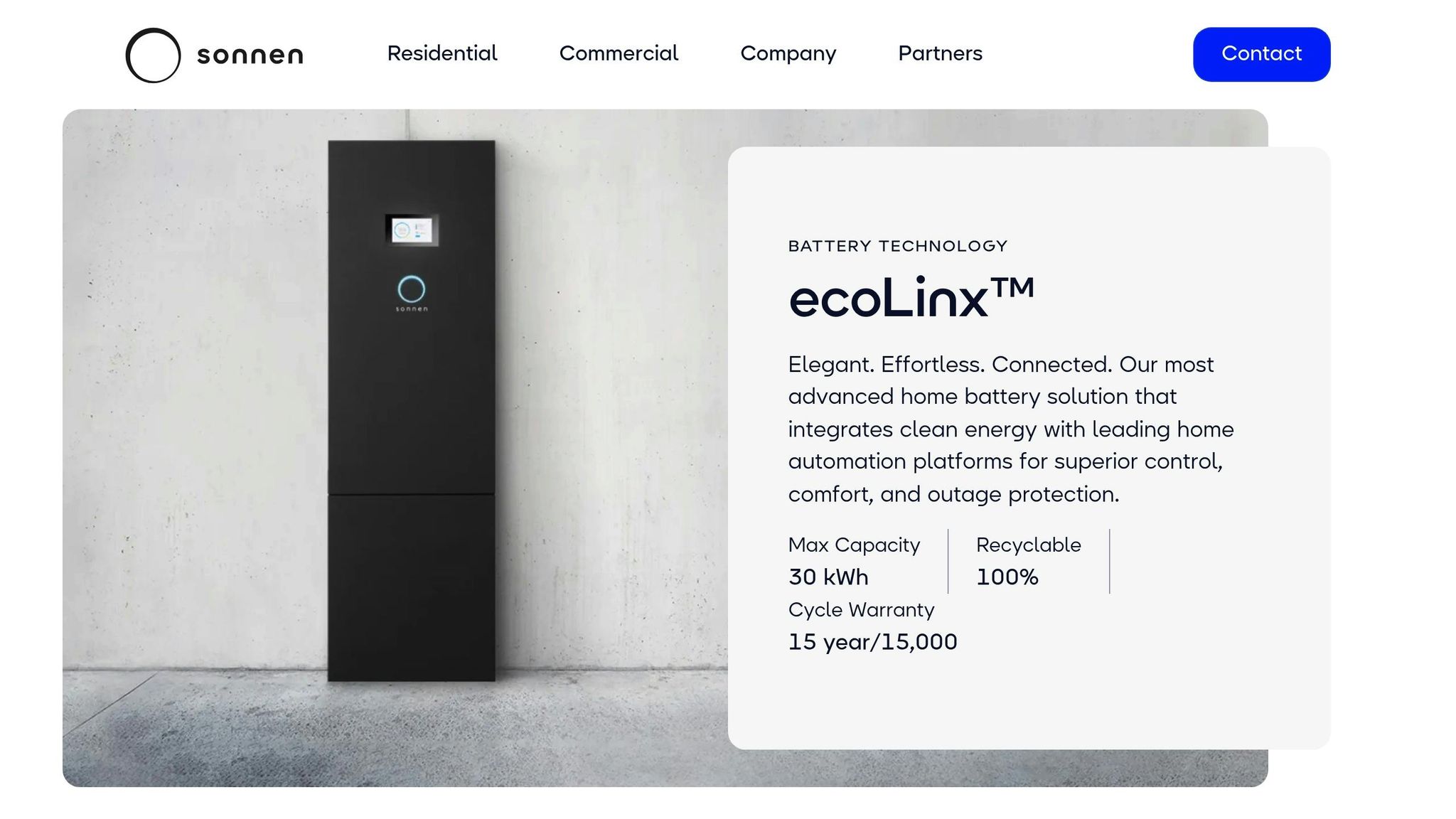
The Sonnen Ecolinx offers more than just energy storage – it combines high-capacity batteries with smart home automation, making it a standout choice for those seeking efficient off-grid energy solutions. Designed in Germany, this system goes beyond storing energy by intelligently managing it throughout the day, ensuring optimal use of solar power, battery reserves, and grid electricity (when available).
What sets the Ecolinx apart is its focus on intelligent energy management rather than simply maximizing storage. Using advanced algorithms, it fine-tunes energy usage, which is particularly useful for off-grid setups where efficiency is key.
The system also integrates seamlessly with popular smart home platforms like Control4, Crestron thermostats, Lutron lighting, and Eaton intelligent circuit breakers. This enables precise control over energy loads, whether during daily use or power outages.
The Sonnen Ecolinx offers a range of capacity options, from 12 kWh to 30 kWh, catering to different household sizes and energy needs. Standard configurations include 12 kWh, 14 kWh, 16 kWh, 18 kWh, and 20 kWh, with a larger 30 kWh option available for homes with greater energy demands. Its modular design allows for customization, with each battery module providing 2 kWh of usable capacity.
This modular setup ensures flexibility and long-term usability, backed by a robust warranty.
The Sonnen Ecolinx is built to last, offering a 15-year/15,000-cycle warranty (whichever comes first). It also guarantees 65% capacity at the end of the warranty period, providing reliable performance for years to come.
The Ecolinx goes beyond basic energy tracking with advanced smart monitoring tools. Features like demand control and load shaping help maximize solar energy usage while avoiding peak electricity rates. One of its standout capabilities is a dynamic weather forecasting system that prepares the battery for potential outages by ensuring it’s fully charged ahead of time.
"This is smart solar. This is actually the solution for energy transition… In other words, you’re reducing your carbon footprint far more and you’re providing a real solution for getting rid of fossil fuel-based power plants. What that also means to you is a lower electric bill." – Blake Richetta, Sonnen CEO
Through the Sonnen app, users can monitor energy production and consumption, analyze trends, and set backup power preferences. The app also allows homeowners to prioritize specific circuits and appliances, ensuring stored energy is used efficiently during an outage. The system switches to battery power in under 100 milliseconds during outages, keeping devices running without interruption. However, it’s worth noting that the Ecolinx has a round-trip efficiency of 81.6%, meaning some energy is lost during the charging and discharging process compared to other systems.
Here’s a side-by-side breakdown of the key specs for several popular off-grid battery systems. These details can help you weigh your options and decide which system aligns best with your energy needs.
| Feature | Bluetti EP900 | Franklin aPower2 | OMO Lithium Batteries | Tesla Powerwall 3 | Sonnen Ecolinx |
|---|---|---|---|---|---|
| Usable Capacity | 9 kWh – 39.6 kWh | 15 kWh | Varies by model | 13.5 kWh | Varies by model |
| Output (Continuous) | 9 kW (18 kW with dual system) | 10 kW | Varies by configuration | 11.5 kW | Varies by model |
| Output (Peak) | 18 kW | 15 kW (10 seconds) | Varies by model | Not specified | Varies by model |
| Cycle Life | N/A | 10,000+ cycles | Varies by model | Unlimited cycles | 15,000 cycles |
| Warranty | 10 years (80% capacity) | 15 years | Varies by model | Unlimited cycle warranty | 15 years / 15,000 cycles |
| Round-Trip Efficiency | Approximately 90–97% | Approximately 90–97% | Approximately 90–97% | Approximately 90–97% | Approximately 90–97% |
| Safety Certifications | UL 9540, NEMA 4X, IP65 | UL 9540, UL 1973 | UL 9540, UL 1973 | Not specified | UL 9540, UL 1973 |
| Smart Monitoring | BLUETTI App | Franklin App | Mobile app monitoring | Tesla App | Sonnen App with AI forecasting |
While the numbers tell part of the story, the practical benefits of these systems depend on your specific needs. For instance, the Franklin aPower2 is a solid choice for high-demand scenarios, offering 10 kW of continuous output. On the other hand, the Tesla Powerwall 3 stands out for its efficiency, minimizing energy loss during charging and discharging cycles.
The Bluetti EP900 brings additional durability to the table with NEMA 4X and IP65 ratings, which protect against corrosion, water, dust, and even ice. As Rich Law, Sr. Engineer at ESS Technical Solutions (CCI), Sungrow, explains:
"UL listing simplifies several steps in the process. It tells installers the system meets a minimum standard in the industry, streamlines the project acceptance process, and eliminates the need for field testing of components."
Warranty terms also vary widely. The Franklin aPower2 and Sonnen Ecolinx offer 15-year warranties, while Tesla provides an unlimited cycle warranty, ensuring long-term peace of mind. The Bluetti EP900 shines with its modular design, scaling from 9 kWh up to 39.6 kWh, making it adaptable to both smaller and larger energy requirements.
Professional installation by certified electricians is key to ensuring these systems operate safely and maintain their warranties. Additionally, smart monitoring apps included with these systems offer valuable insights into energy consumption, helping you fine-tune performance and quickly address any issues that arise.
Selecting the right off-grid battery system means finding one that aligns with your capacity, power, and budget needs. For example, the Bluetti EP900 stands out with its ability to scale, making it a great choice for growing energy demands. The Franklin aPower2 is known for its strong performance and comes with a 15-year warranty, while the Tesla Powerwall 3 offers balanced functionality and an unlimited cycle warranty.
When it comes to costs, expect typical units to range between $1,000 and $2,000 per kWh. Smaller systems under 8 kWh might cost less than $10,000 before installation, while whole-home setups can climb to $22,000 or more.
The size of your application plays a big role in determining which system is the best fit. The OMO Lithium Batteries provide versatile setups for various uses, while the Sonnen Ecolinx caters to larger installations with advanced features. Be sure to evaluate your current energy use and consider future growth when deciding on capacity.
Integration and installation are just as important as capacity and cost. Some systems are DIY-friendly, but many require professional installation to ensure safety and maintain warranties. Hiring a certified electrician ensures the system is installed correctly and meets local codes.
Warranty coverage is another key factor, offering protection for your investment and ensuring reliability over the system’s lifespan. A solid warranty gives you peace of mind and long-term confidence in your battery system.
For those in the Ottawa Valley, professional installation and ongoing support are crucial for getting the most out of your battery system. Draper Electric specializes in installing and maintaining battery storage and backup systems. Their team ensures compliance with local electrical codes and optimizes your system for peak performance. With their expertise, you’ll have a reliable setup that lasts for years.
Take the time to assess your energy needs, compare product specifications, and account for installation costs. By reviewing your daily energy use, expansion plans, and installation preferences, you can choose the system that best suits your needs and ensures long-term reliability.
Choosing an off-grid battery system isn’t just about picking any option off the shelf – it requires a bit of planning to ensure it matches your energy needs and runs smoothly. Start by figuring out how much energy you use daily, measured in kilowatt-hours (kWh), and identify your peak power requirements. These numbers will guide you in selecting both the right battery capacity and type. For example, lithium-ion batteries offer a longer lifespan and better efficiency, while lead-acid batteries come with a lower upfront price tag.
Another key factor to examine is the battery’s depth of discharge (DoD) – this tells you how much of the battery’s capacity you can use without shortening its life. Batteries with a higher DoD give you more usable energy. You’ll also want to look at round-trip efficiency, which tells you how much of the energy you store can actually be retrieved. Make sure the system can adapt to seasonal changes in energy production, especially if you’re relying on renewable sources like solar or wind.
Planning for the future is just as important. Think about whether you’ll need to expand your system down the road. And don’t forget to check that your setup meets local regulations – this ensures your system runs reliably and avoids any compliance issues.
Smart Monitoring Features in Off-Grid Battery Systems
Smart monitoring features bring a new level of convenience and efficiency to off-grid battery systems. By delivering real-time data on energy usage, battery health, and system efficiency, these tools help users stay informed and in control. For instance, you can monitor key metrics like charge levels and temperature, which are crucial for avoiding problems like over-discharge or overheating – issues that can significantly reduce a battery’s lifespan.
These systems also provide instant alerts when critical conditions arise, allowing users to act quickly and prevent potential damage. This not only cuts down on maintenance but also boosts the system’s reliability. With smart monitoring, managing energy becomes much simpler, ensuring your off-grid power setup runs smoothly and efficiently over time.
Investing in an off-grid battery system can lead to significant long-term savings while offering a host of other advantages over traditional energy sources. By capturing and storing surplus energy from renewable sources like solar panels, homeowners can cut down – or even entirely eliminate – their monthly utility bills. Plus, it shields them from rising electricity costs and provides energy independence, which is especially useful during peak demand periods or in areas prone to frequent power outages.
These systems also play a role in reducing reliance on fossil fuels, helping to lower greenhouse gas emissions. While the upfront cost may be higher, the combination of reduced expenses, dependable energy access, and eco-friendly benefits makes off-grid battery systems a smart investment for those looking ahead.